#Tetraodontidae
Explore tagged Tumblr posts
Text
Pufferfish page!!! The animal intrest is never ending. Shout out to tiny tot me with their ungodly amount of animal knowledge.





Tetraodontidae otherwise known as the Pufferfish are apart of the order Tetraodontiformes. They are known for their ability to "puff" up when threatened (like their name!!!). They do this by inhaling large amounts of water or air into their elastic stomachs. This makes them much larger and unappealing to predators.
Unlike their close relative the Porcupinefish, Pufferfish don't have spines. Some might have pointy bumps and a rough texture instead.
A majority of Pufferfish species are poisonous, their liver and skin contain a toxin called Tetrodotoxin or TTX. TTX is one of the most powerful neurotoxins, significantly stronger then cyanide. It disrupts nerve function, paralyzing and even killing victims.
#artwork#my art#art#traditional art#Animals#Animal art#pufferfish#Tetraodontidae#Animal info dump#Animal facts#Minecraft Pufferfish#I love these creatures so much#I tried my best with my info but my sources were contradicting eachother#I tried my best o7
8 notes
·
View notes
Note
🥚 hey!!! I'd love something from the ocean or a dog-like creature (idk fur and four legs? Haha :v) have a great day!!!! 🐈⬛🐅🐆🦌🦬🐂🐪🦙🐘🦛🦔🦥🦦🦨🦘🦡🦆🦤🦩🐊🦎🦕🦖🐋🦭🐠🐡🦈🐙 ( also plz no spiders?)
Gonna split the difference for you


Dog-faced puffer!
(Arothron nigropunctatus)
72 notes
·
View notes
Text
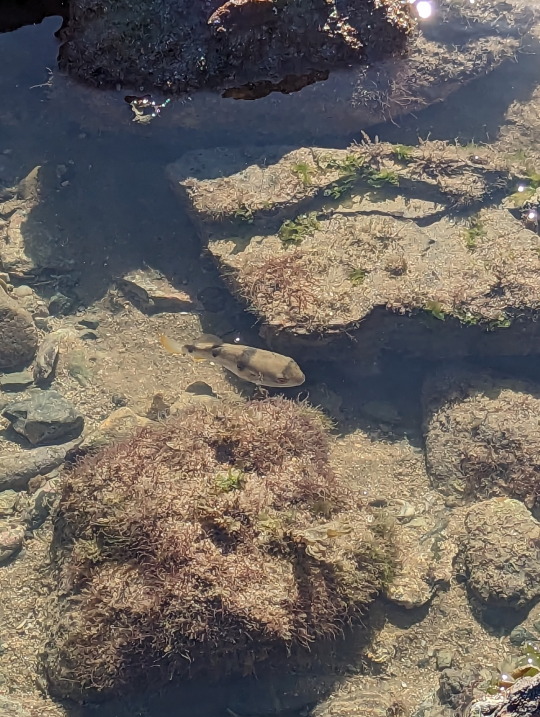

Banded Toadfish spotted in a tidepool.
16/05/23 - Marilyna pleurosticta
QLD:CQC - Emu Park, rocky shoreline
#Marilyna pleurosticta#Banded Toadfish#Chordates#Chordata#Tetraodontidae#Pufferfishes#Actinopterygii#Ray-finned Fishes#Vertebrata#Vertebrates#fish#fishblr#tidepooling#marine biology
43 notes
·
View notes
Text
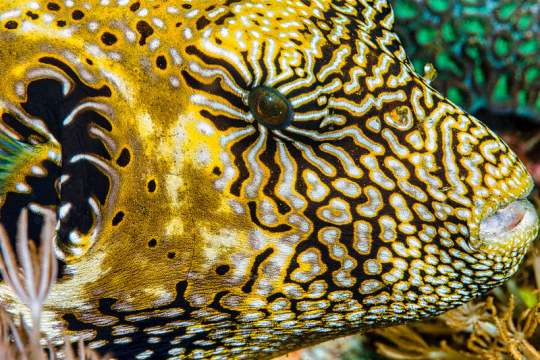
A map pufferfish (Arothron mappa) off the coast of South Rinca Island, Indonesia
by François Libert
#map pufferfish#pufferfish#bony fish#fish#arothron mappa#arothron#tetraodontidae#tetraodontiformes#actinopterygii#chordata#wildlife: indonesia#wildlife: asia
51 notes
·
View notes
Text

#IFTTT#Flickr#commontoadfish#tetractenoshamiltoni#common#toadfish#tetractenos#hamiltoni#botanybay#sydney#newsouthwales#australia#animalia#chordata#vertebrata#actinopterygii#tetraodontiformes#tetraodontoidei#tetraodontidae#new#south#wales#botany#bay#fish#fishing#animal#wild#wildlife#nature
4 notes
·
View notes
Text






mall fishies:)
#fish#fishes#pufferfish#blue tang#idk the other fish names :(#marine animals#aquatic animals#marine life#fishies#fish tank#fishblr#tetraodontidae#puffer fish#blue tang fish
6 notes
·
View notes
Text

youtube
youtube
#Tetraodontidae#globefish#kugelfisch#fish#tank#aquarium#Marsbéli Krónikák#martian#chronicles#nature#ocean#wheel of ashoka#ashoka chakra#ashoka
1 note
·
View note
Text

0 notes
Text

MerMay's 17th mermaid was a Pufferfish!
#art#mermay#mermay 2023#mermaid#pufferfish#puffer#tetraodont#tetraodontidae#fish#pencil#traditional art#daily#artists on tumblr#valerianart
1 note
·
View note
Note
Why is Reginald named Reginald? I know that his last name is probably based off a Tetraodontidae but what about the first name?
Literally I was just like "what's the most pretentious name I can think of" and that was it
56 notes
·
View notes
Text
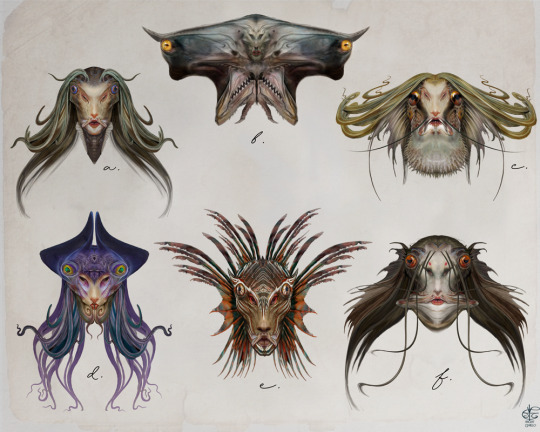
The class of Sirenia is a vast and wide net of varying aquatic humanoids. Highly dimorphic and adaptable, mermaids (or merfolk) can be found in nearly every aquatic body, be it oceans, which has the largest number of species, to ponds and lakes. This adaptability and dimorphic nature of the species has allowed them to thrive across the globe. Despite their vast differences in appearances, one thing you’ll see consistently across the various species of Merfolk is the unique “false face” adaptation.This illusionary facial feature is believed to have evolved as a defense mechanism. The “true eyes” are typically located on the far side of their heads. While it’s “false eyes” are situated at the front, like that of a human’s. These false eyes are highly sensitive receptors.
Noted species in the attached diagram
A. Sirenia Atlanticus
B. Sirenia Sphyrnidae
C. Sirenia Tetraodontidae
D. Sirenia Decapodiformes
E. Sirenia Pterois
F. Sirenia Eurypharynx
#concept art#creature design#fantasy art#creature concept#monster#speculative evolution#dragons#speculative biology#bestiary#mythological creatures#mythology#fantasy illustration#mermaid#merfolk#mermay#kraken#squid#octopus#hammer head
630 notes
·
View notes
Text
Well, Well... whale 🐋? If it isn't that time of year!
Hello you lovely ballpit goers! We here at DCFP have been hard at work behind the scenes on events to make sure you have tons of entertainment this mermay to draw with!
Presenting you with... The official Daycare Friend Pickup Mermay Prompt List for 2024!
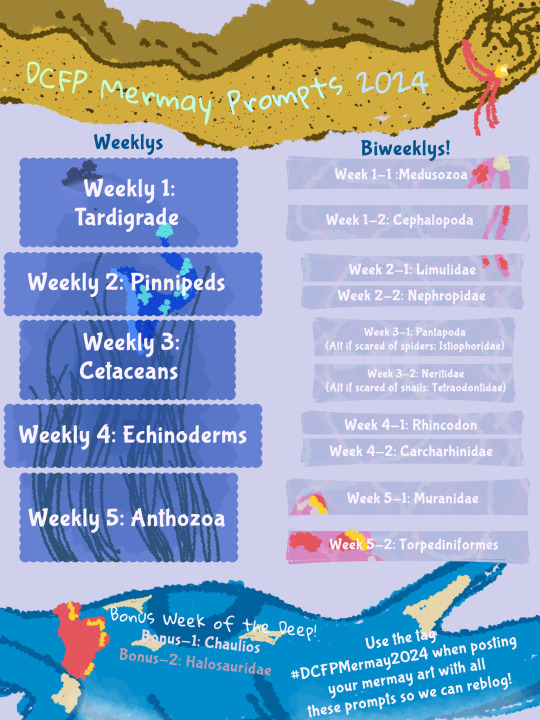
We've got quite a variety up here for you all to choose and draw from this year! And for us to see it all, you'll have to make sure you tag it as #dcfpmermay or #dcfpmermay2024 !
Here's the prompt list broken down in more order!
Weekly
1. Tardigrade
2. Pinnipeds (Seals, Walruses, Sea Lions etc)
3. Cetaceans (Dolphins, Whales, Orcas, etc)
4. Echinoderms (Starfish, Brittle Stars, Sea Urchins, Sea Urchins, etc)
5. Anthozoa (That's right folks, coral is a sea creature too! Time to pump out the creativity on this week!)
Biweekly Prompts (That means one every half a week!)
•Week One
1. Medusozoa (Jellyfish)
2. Cephalopoda (Octos, Squids, Cuttles, and Nautilus!)
•Week Two
1. Limulidae (Horseshoe Crabs)
2. Nephropidae (Lobster time babes! 🦞)
•Week Three
1. Pantapoda (Sea Spiders) [Istiophoridae AKA Marlins this week if spider things freak you out]
2. Neritidae Aka Freshwater Snails/Nerites [Tetraodontidae AKA Pufferfish if Snails freak you out]
•Week Four
1. Rhincodon (Whale Shark)
2. Carcharhinidae (Requiem Sharks)
•Week Five
1. Muranidae (Moray Eels)
2. Torpediniformes (Electric Rays ⚡)
Bonus week of The Deep
(For if you finished everything else but want to do a little more!)
1. Chaulios (Viperfish)
2. Halosauridae (Halosaurs)
The event will go on from April 28th to June 2nd to give everyone who wants to pump out those mermaid drawings all that extra time to put love and attention into these prompts!
And remember, you do NOT have to do all of them! Just do what you feel comfortable with and draw to your fishy daycare's freedom ❤️.
Get ready folks, because it's going to be a splashing Mermay here at the pickup! 🌊
72 notes
·
View notes
Text
Daily fish fact #531
Pufferfish!
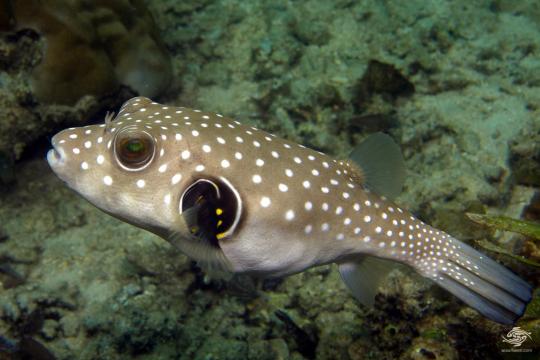
The pufferfish family’s name, Tetraodontidae, refers to their four large teeth which they use to crush hard-shelled prey’s defences!
#fish#fish facts#fishfact#marine biology#marine life#marine animals#sea animals#sea creatures#sea life#biology#zoology#pufferfish#blowfish
173 notes
·
View notes
Text
How Knowledge Can Puff Up the Christian

by Jack Wellman
How does knowledge puff us up or make us prideful so we can avoid it happening to us. It made me think of the Blowfish (family of Tetraodontidae) which are closely related to the Porcupine fish and Puffer fish. These fish are analytical to the idea of biblical knowledge that comes without love. These fish are the second most poisonous vertebrate in the known world, being highly toxic to humans. Their unique and distinctive natural defenses have the ability to inflate rapidly. Some puffers also produce a powerful neurotoxin called tetrodotixon in their internal organs, making them unpleasant, and even lethal…
continue this article at What Christians Want to Know
6 notes
·
View notes
Note
do you agree that pufferfish are the original tummygirls
look
listen
okay
i knew a lot of people who did improv, back in the city. friends of mine for a bit, some of them. the desire to yes-and this kind of question is strong in me, from that time of my life, and just from being, you know, a charming witch.
when a pal of mine tells a joke i'm right there to build them up. for the sake of the bit.
but this. this i cannot countenance. i mean no offense to the noble family Tetraodontidae. they've been doing their thing for 90 million years or more and they do it well.
but a tummygirl is fat. not some puffed up piscine pretender. you come to me with these questions about fish and women and i tell you i am a fat dyke who loves fat dykes and thats that.
and thats why women want me and why fish fear me.
58 notes
·
View notes
Note
puffer fish :3
Animal of the day: Puffer fish!
Pufferfish are fish belonging to the family Tetraodontidae. Their Latin name refers to their four large teeth, fused into an upper and lower plate, which are used for crushing the hard shells of crustaceans and molluscs, their natural prey.

They inflate by filling their elastic stomachs with vast quantities of water or air. This is a technique to evade predators, to make themselves seem too large to eat. They also have spines on their skin containing poison, which is foul tasting and often deadly.

Pufferfish teeth never stop growing, they are naturally worn down by the hard shells of their prey!

21 notes
·
View notes